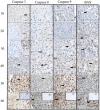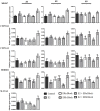An approach to uncover the relationship between 17b-estradiol and ESR1/ESR2 ratio in the regulation of canine corpus luteum
- PMID: 35982918
- PMCID: PMC9378837
- DOI: 10.3389/fvets.2022.885257
An approach to uncover the relationship between 17b-estradiol and ESR1/ESR2 ratio in the regulation of canine corpus luteum
Abstract
The canine corpus luteum (CL) is able to synthetise, activate and deactivate 17b-estradiol (E2) and also expresses nuclear estrogen receptors in a time-dependent manner during diestrus. Nevertheless, we are still missing a better comprehension of E2 functions in the canine CL, especially regarding the specific roles of estrogen receptor alpha (ERa) and ERb, encoded by ESR1 and 2, respectively. For that purpose, we analyzed transcriptomic data of canine non-pregnant CL collected on days 10, 20, 30, 40, 50 and 60 of diestrus and searched for differentially expressed genes (DEG) containing predicted transcription factor binding sites (TFBS) for ESR1 or ESR2. Based on biological functions of DEG presenting TFBS, expression of select transcripts and corresponding proteins was assessed. Additionally, luteal cells were collected across specific time points during diestrus and specificity of E2 responses was tested using ERa and/or ERb inhibitors. Bioinformatic analyses revealed 517 DEGs containing TFBS, from which 67 for both receptors. In general, abundance of predicted ESR1 targets was greater in the beginning, while abundance of ESR2 targets was greater in the end of diestrus. ESR1/ESR2 ratio shifted from an increasing to a decreasing pattern from day 30 to 40 post ovulation. Specific receptor inhibition suggested an ERa-mediated positive regulation of CL function at the beginning of diestrus and an ERb-mediated effect contributing to luteal regression. In conclusion, our data points toward a broad spectrum of action of E2 and its nuclear receptors, which can also act as transcription factors for other genes regulating canine CL function.
Keywords: 17b-estradiol; ESR1; ESR2; diestrus; dog; progesterone.
Copyright © 2022 Bonfim Neto, Cardoso, Silva, Sousa, Giometti, Binelli, Bauersachs, Kowalewski and Papa.
Conflict of interest statement
The authors declare that the research was conducted in the absence of any commercial or financial relationships that could be construed as a potential conflict of interest.
Figures







Similar articles
-
Luteal expression of factors involved in the metabolism and sensitivity to oestrogens in the dog during pregnancy and in non-pregnant cycle.Reprod Domest Anim. 2022 Jan;57(1):86-97. doi: 10.1111/rda.14032. Epub 2021 Nov 10. Reprod Domest Anim. 2022. PMID: 34704613 Free PMC article.
-
Factors affecting the fate of the canine corpus luteum: Potential contributors to pregnancy and non-pregnancy.Theriogenology. 2020 Jul 1;150:339-346. doi: 10.1016/j.theriogenology.2020.01.081. Epub 2020 Feb 19. Theriogenology. 2020. PMID: 32089321
-
Endometrial prostaglandin synthases, ovarian steroids, and oxytocin receptors in mares with oxytocin-induced luteal maintenance.Theriogenology. 2017 Jan 1;87:193-204. doi: 10.1016/j.theriogenology.2016.08.028. Epub 2016 Sep 8. Theriogenology. 2017. PMID: 27773348
-
Estrogen and Glycemic Homeostasis: The Fundamental Role of Nuclear Estrogen Receptors ESR1/ESR2 in Glucose Transporter GLUT4 Regulation.Cells. 2021 Jan 7;10(1):99. doi: 10.3390/cells10010099. Cells. 2021. PMID: 33430527 Free PMC article. Review.
-
Luteal regression vs. prepartum luteolysis: regulatory mechanisms governing canine corpus luteum function.Reprod Biol. 2014 Apr;14(2):89-102. doi: 10.1016/j.repbio.2013.11.004. Epub 2013 Dec 21. Reprod Biol. 2014. PMID: 24856467 Review.
References
-
- Kowalewski MP, Beceriklisoy HB, Aslan S, Agaoglu AR, Hoffmann B. Time related changes in luteal prostaglandin synthesis and steroidogenic capacity during pregnancy, normal and antiprogestin induced luteolysis in the bitch. Anim Reprod Sci. (2009) 116:129–38. 10.1016/j.anireprosci.2008.12.011 - DOI - PubMed
LinkOut - more resources
Full Text Sources
Miscellaneous

